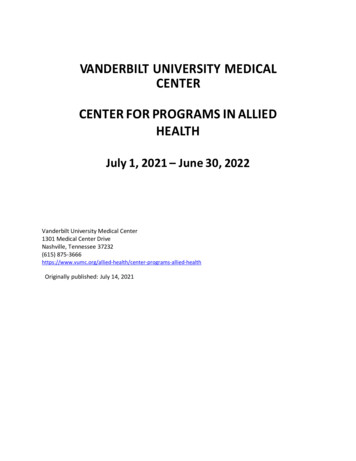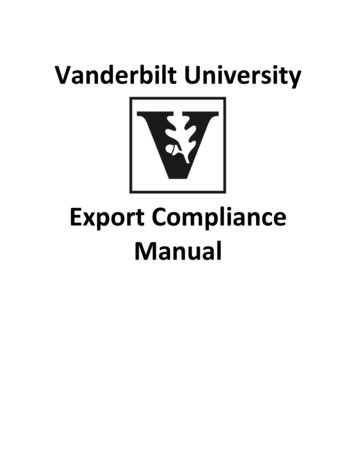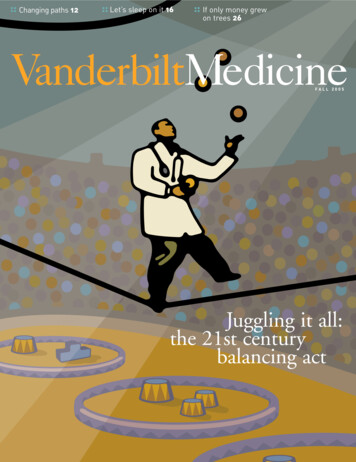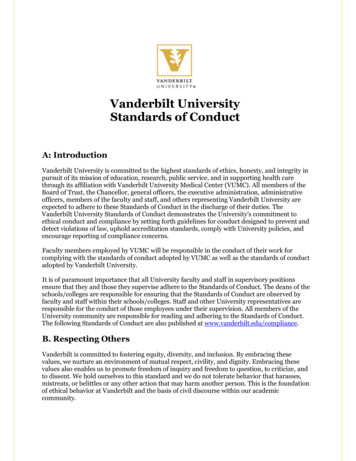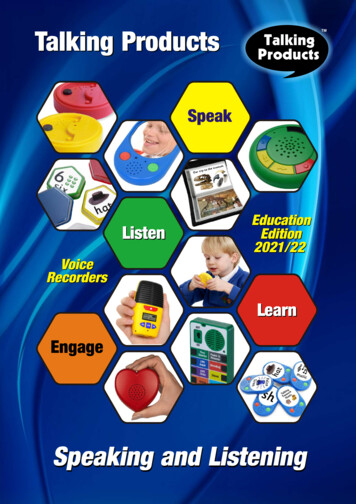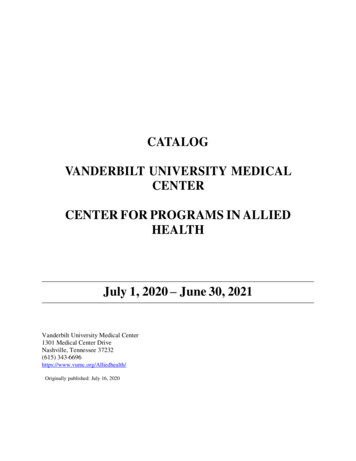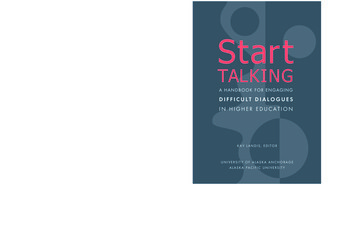
Transcription
universities who have spent several years exploringproductive ways to engage difficult dialogues inclassroom and other academic settings.It presents a model for a faculty developmentintensive, strategies for engaging controversialtopics in the classroom, and reflections from thirty-fivest a r t t a l k i n gThis book tells the story of a partnership between twofaculty and staff members who have field-tested theStartTalkingA Handbook for ENGAGINGtechniques. It is intended as a conversation-starter andDifficult Dialoguesfield manual for professors and teachers who want tostrengthen their teaching and engage their studentsin Hi g h er E du c ationmore effectively inconversations about the mostimportant issues of our time.U AA / A P UKAY LANDIS, EDITORU N i v ersity o f A laska A n c h ora g eA laska P a c i f i c U ni v ersity
StartTalkingA H a n d b o o k f o r E N G A G IN GDifficult Dialoguesi n H i ghe r E d u c a t i o nK ay L andis, Edito rProduced in partnership byThe University of Alaska Anchorageand Alaska Pacific UniversityMade possible through the generous support of theFord Foundation Difficult Dialogues Initiative
Copyright 2008 by the University of Alaska Anchorage and Alaska Pacific UniversityPublished by:University of Alaska AnchorageFran Ulmer, Chancellor3211 Providence DriveAnchorage, AK 99508Alaska Pacific UniversityDouglas North, President4101 University DriveAnchorage, AK 99508A major source for this handbook is Discussion as a Way of Teaching (2nd Edition) by Stephen D. Brookfield andStephen Preskill, copyright 1999, 2005 by John Wiley & Sons, Inc. Quotations and techniques reprinted withpermission of John Wiley & Sons, Inc.Limit of Liability/Disclaimer of Warranty: While the editors, contributors, and publishers have made their best efforts inpreparing this handbook, they make no representations or warranties with respect to the accuracy or completeness ofthe contents. The advice and strategies contained herein are presented in a shorthand format and may not besuitable for all situations. Readers are encouraged to use this material as suggestions rather than prescriptions and toconsult with other texts and professionals where appropriate.ISBN: 978-0-9702845-3-2
Associate EditorsDr. Patricia JenkinsAssociate Professor of EnglishUniversity of Alaska AnchorageLibby RoderickAssociate Director, Center for Advancing Faculty ExcellenceUniversity of Alaska AnchoragePaola BancheroAssistant Professor of Journalism and Public CommunicationsUniversity of Alaska AnchorageJohn DedeSpecial Assistant to the Senior Vice ProvostUniversity of Alaska AnchorageDesignDavid Freeman (Freeman Design)Original art by David Freeman
Table of ContentsiIntroductionixWho We Are1Ground Rules12312182226303335Faculty Intensive, Day OneTales from the TrenchesAcademic FreedomEstablishing Discussion RulesAt Stake: Faculty PerformanceSafetyPausing for ReflectionBalancing Safety and RiskDifficult Dialogue: Meeting Learner ExpectationsStart Talking: Questions for Discussion2Rhetoric, Debate3738404753647476Faculty Intensive, Day TwoSpeaking the LanguageRhetorical QuestionsRhetorical PurposesDebateCombining Elements: the Justice Talking FormatDifficult Dialogue: Majorities and MinoritiesStart Talking: Questions for Discussion3Race, Class, Culture777879828592104109117120122Faculty Intensive, Day ThreeSpeaking the LanguageIdentityPrivilegeCultureCircle of ObjectsVoicing Minority ViewsThe Five Minute RuleCulturally Responsive TeachingDifficult Dialogue: Fitting Everything InStart Talking: Questions for Discussion
4Science, Religion123124135140157160Faculty Intensive, Day FourStarting the ConversationStaying in the ConversationFraming the ConversationDifficult Dialogue: Native Ways of KnowingStart Talking: Questions for Discussion5Business, Politics, Social Justice161162170194206208209Faculty Intensive, Days 5-365BusinessPoliticsSocial JusticeSpeaking the LanguageDifficult Dialogue: Learning from ExperienceStart Talking: Questions for Discussion6Outcomes211212217231238239Faculty Intensive: OutcomesThe Faculty Intensive ModelChanging the Way We TeachStudent OutcomesOverall OutcomesStart Talking: Questions for Discussion7Keep Talking241242244246247Faculty Intensive: The One We Didn’t ChooseIntegration of Academic and Alaska Native CulturesAlaska’s Native Peoples: A Call to UnderstandingLessons Learned/New BeginningsEpilogue249 References255 Index of Contributors256 Index of Techniques
Introduction“Civil Discourse Under Fire”You probably won’t see the above words as a headline in your morning newspaper any time soon,but it’s happening nonetheless. Civil discourse seems to be in trouble. The art of respectful argumentand the effort to find mutual solutions seem to be losing ground. Our public debates on critical issuesare filled with sound bites instead of substance, and our popular culture seems motivated more by thedesire to dominate and win than by the commitment to learn, understand, seek common ground,or persuade.There’s trouble in the Academy too. Faculty members are challenged for bringing gender,religion, science, or politics into their classrooms. Students find themselves marginalized or evenattacked for their world views or religious beliefs. Outbursts that aren’t managed effectively canleave students feeling threatened and faculty feeling out of control, turning class discussions intoemotionally or spiritually destructive experiences instead of the learning experiences they aremeant to be.Civil discourse is the cornerstone of theuniversity experience, and our classroomsIn today’s violent world, the expectations thatand laboratories are ideal venues foruniversity faculty carry into the classroom mayteaching it. As standard practice, weseem outlandishly ideal. Against enormouschallenge our assumptions, question whatodds, we still expect the classroom to be a safewe know, and seek new understandingplace to think, probe, and argue about ideas.rather than rigidly defending what we haveThis expectation has been fostered overdeveloped in the past. In this process ofmillennia, in times no less perilous—and manyinquiry, we rely on critical thinking,times even more so—than our own. It is a partinclusiveness, tolerance, and respect toof the university tradition that our best hopecreate new knowledge and reframe oldfor understanding each other and for resolvingtenets to the emerging world.our differences comes from the free exchangeUniversities show students how toand exploration of ideas—new and received—intranscend the boundaries of their ownthe Academy. The possibility for such freedomperceptions, and engage respectfully withcomes paradoxically from submitting to thenew ideas. Now, as ever, this may be higherdiscipline of the liberating arts. It falls to oureducation’s most important role. Now iswatch, as to every other that has preceded ours,the time, and our campuses are the place, toto protect these premises for civilized exchange.rebuild a culture of civil discourse.Dr. Marilyn BarryAcademic DeanAlaska Pacific Universityi
Need for Faculty DevelopmentBy and large, university professors begin their faculty careers with fresh degrees and highly refinedacademic and research skills. We are content experts. We know our subjects; we can write aboutthem, talk about them, research them, defend them. But most of us have spent very little time learning how to teach and virtually none preparing ourselves to deal effectively with controversy. Ask uswhat to do about the biblical literalist who challenges our teaching of evolution, the insensitivestudent who makes a racial slur, the conservative who complains about our liberal bias, the aggressive student in the front row who dominates the conversation, or the quiet one inthe back who never says a word, and sudEngagement is not built on students working indenly the room goes silent. What shouldsoup kitchens for academic credit, nor is it builtwe do when these things happen in ouron faculty members applying their expertise inclassrooms? Many of us don’t really know.the community as the basis for an academicpaper. A truly engaged society begins whentwo people with vastly different life experiencessit down together, share their deepest thinkingabout the challenges facing our world, and aretransformed as a result. As engaged universities,we must re-learn the tools of civil discourse inpartnership with the generations that will buildthe future.The ProjectWith these issues foremost in our minds,leaders from two Alaska universities—Alaska Pacific University (APU) and theUniversity of Alaska Anchorage (UAA)—formed a partnership and designed a project to teach ourselves some new skills.Our goal was ambitious: to improve theDr. Michael A. Driscolllearning climate on our campuses, makingProvost and Vice Chancellor for Academicthem more inclusive of minority voicesAffairsand ways of knowing and safer places forUniversity of Alaska Anchoragethe free exchange of ideas.Although neighbors, we came fromvery different academic worlds. UAA is amulti-campus public university—the largest in the state—with a mission that includes access,excellence, engagement, and diversity. APU is a small private university—once Methodist, nowindependent—with a mission emphasis on active learning and on nurturing spiritual and moralvalues consistent with its Christian heritage while respecting the religious convictions of all. Thetwo universities sit side by side on a forested strip of land just east of midtown Anchorage, sharinga library and a magnificent view of the Chugach Mountains. But we also share a competitive andsometimes contentious history. In fact, let’s be honest here. We didn’t trust each other completely.But we thought: who knows? Maybe this time we can all just get along.We dreamed together. A hand-picked group of us—professors, administrators, and staff—sataround a conference table in our shared library and played the “what if” game. What if we couldtrain ourselves to handle controversy better? What if we could change the way we teach? What if wecould really make our campuses more inclusive and safer places for learning?For several weeks, these conversations were the highlight of our days: lively, full of big ideas andeasy laughter. We discovered that, for all of our differences, we shared the same basic values and thesame optimism and hopes. There was a problem. We could do something about it. It could be scary,but it could also be fun. We could make a difference.ii
The conversations led to a proposal, and the proposal led to a funding source. Early in 2006, theFord Foundation awarded us a two-year grant as part of its national Difficult Dialogues initiative. Ourproject was one of twenty-six throughout the U.S. to be included in the initiative, a fact we traded onshamelessly in the coming months to garner additional support. The Ford Foundation name carries alot of weight. We were part of something big.Our central strategy was threefold: to train ourselves via a series of faculty intensives, to go outand teach differently for a year, and then to come back together to share what we had learned. Wedeveloped a curriculum for a week-long faculty intensive, designed a competitive application process,set up stipends for participants and expectations for what they should accomplish, and selected aninitial cohort of thirty faculty members. We set aside two weeks in May, in between our commencements and the start of our summer terms, to hold the first two intensives back to back. We took adeep breath and got started.StrategiesFaculty Fellowship ProgramWe invested about half of our grant money directly in our faculties by creating a fellowship programthat paid stipends for project participation. We used a selective application process, choosingparticipants (Fellows) based on their experience, motivation, and capacity for advancing the cause.We consciously selected an interdisciplinary cohort that included both junior and seasoned professors.Tales fromFacultyFellowshipthe TrenchesA method of bringing faculty members together into a cohort to strengthen their skills, renew theirpurposes, and cultivate leaders.Make it selective.Use an application and interview process to select an engaged cohort with the potential to becomementors and leaders.Mix it up.Create as much diversity as you can. Actively recruit applicants from a variety of disciplines,ethnicities, cultures, and political persuasions.Expect a lot.Expect them to practice or achieve certain things and tell them clearly and often what thosethings are.Reward them.Value their time, experience, and creativity with recognition, respect, and stipends.iii
The thirty chosen Fellows came from two universities, three campuses, five schools, and eighteendisciplines. A few of them already knew each other well: the four English professors from UAA, forexample, and all five professors from APU. Others knew each other only by reputation. Many werecomplete strangers who met each other for the first time around our conference table. It was the firsttime we knew of that APU and UAA faculty had sat down together at the same table with the samepurpose.The Fellowship required commitment. Each member would attend a week-long intensive in May.There would be two of these to choose from (similar in content, just held different weeks), withfifteen Fellows in each. Participants agreed to take what they learned from the experience into theirclassrooms during the following academic year (August to April), engaging their students in one ormore difficult dialogues and field-testing one or more new techniques. They would meet again twiceas a full group, once for a day in January, and again for a three-day evaluation retreat the followingMay. Optional informal gatherings were encouraged. They were expected to collaborate, engage,support each other, fail, try again, learn from experience, learn from each other, grow.Faculty IntensiveA faculty committee designed the basic week-long curriculum, structuring it around a few big themessuch as race, class, culture, science, and religion. The idea was to approach each topic by modelinga few simple techniques: ideas we could potentially bring into our own classrooms to reach differentTales fromFaculty Intensivethe TrenchesA faculty development opportunity that focuses on critical topics and takes place over several days.TimingHold it at the beginning of the summer break, after spring grades are in but before everybody getstoo far from campus.CurriculumLink difficult dialogues in race, gender, class, culture, science, religion, politics, and/or social justicewith strategies and techniques for engaging in productive discussion. Enlist colleagues andcommunity members to address areas of particular concern for your campus.PresentationVary your presentation styles. Try a number of new techniques. Stay flexible. Check in with folksregularly. Make time to engage in the actual difficult dialogues that arise within the group.Free lunchTake breaks. Feed and water the group regularly. Think healthy: fruit, yogurt, light snacks,sandwiches, salads. No doughnuts. Make an effort to limit the amount of trash generated, usingcutlery, cups, and plateware made from environmentally sustainable products.iv
kinds of learners, lead to more productive discussions,and promote deeper kinds of learning. We foundmany of these techniques in Discussion as a Way ofTeaching by Stephen Brookfield and Stephen Preskill,which we adopted as our text. But we also relied largely on the strengths of our own faculty and staff to actas colleague-to-colleague teachers, with the idea thatfaculty would learn best from each other. We decidedto both introduce new approaches and experience themourselves wherever possible; we wanted to have a bitof firsthand knowledge of how the techniques might bereceived by our students.We held two intensives that first year. The dailyagendas varied slightly but followed roughly the sameprogression. On the first day, we considered facultyrights and responsibilities with regard to academicfreedom, shared the difficulties we’ve encountered inour own classrooms, and learned how to handledisruptive students. Day Two was devoted to Westerntraditions of civil discourse, particularly rhetoric anddebate. On the third day we addressed issues of race,class, and culture, with an emphasis on the indigenousAlaska Native cultures in our midst. Day Four wasreserved for science and religion. And on Friday wetried to tie it all together before setting everyone free topractice on their own.Faculty Intensive: Sample AgendaDay 1:Academic FreedomTales from the TrenchesCodes of ConductHow to Handle Disruptive StudentsDay 2:Questions and CategoriesRhetoricDebateDay 3:White PrivilegeCulturally Sensitive TeachingCircle of ObjectsThe Five Minute RuleDay 4:Theological ArgumentsScience and ReligionRole PlayingDay 5:Difficult DialoguesTaking It Out Into the WorldFew professors receive training in bestpractices for teaching, and fewer still inhow to tackle controversial issues orhandle conflict, prior to being tossed intotheir own classrooms to teach. If we wantour universities to remain vital traininggrounds for engagement in a democraticsociety, we must model ways to conductcivil discourse in the classroom. In orderto do this, we need to offer more facultydevelopment opportunities like this one.The intensives offer a rare opportunityfor faculty to form a true learningcommunity around a highly significantteaching challenge: how to addresstough topics in the classroom. Theyquestion, collaborate with, and learnfrom one another as they encounterviewpoints, issues, personal biases, anddisciplinary perspectives different fromthose they typically meet in theireveryday academic lives.Lauren BruceDirectorLibby RoderickAssociate DirectorCenter for Advancing Faculty ExcellenceUniversity of Alaska Anchoragev
Book of the YearThe two universities also launched a joint Books of the Year program in the fall of 2006 to give us ashared platform for raising controversial issues that our students and campuses could address together. APU had tried something similar the previous year, using Thoreau’s Walden and Aldo Leopold’sA Sand County Almanac and Sketches Here and There to illuminate themes related to ecological sustainability. We built this new effort from their experience.We invited the faculties of both universities to submit book nominations. We told them we werelooking for controversy, that we preferred fiction, and asked them to recommend short works thatwould be accessible to all students, including our under-prepared, international, and English as aSecond Language (ESL) populations. Our selection process resulted in two very different books thatexplore themes of cultural conflict, immigration, and assimilation. We promoted them as Books ofthe Semester that first year, with Anne Fadiman’s The Spirit Catches You and You Fall Down forthe fall and T.C. Boyle’s The Tortilla Curtain in the spring. We invited both authors to visit ourcampuses, and Boyle accepted, arriving in the spring for a public reading and discussion with severalfaculty and student groups.Tales fromBook of the Yearthe TrenchesSome ideas for using a Book of the Year program as a platform for difficult dialogues.Choosing a book: questions for discussionllllllWhat themes do you want to explore, and can you link them to current events or local initiatives?How many disciplines will be likely to participate in discussion?Do you prefer fiction or nonfiction?How much does length or reading level matter?How much do the author’s ethnicity, gender, politics, or credentials matter?Is it important that the author be potentially available for a campus reading or workshop?ImplementationIt can take up to a year of advance planning to launch a successful Book program.Fall: Announce the theme and selection parameters for the coming year. Solicit nominations fromacross the campus. Appoint a review committee.l Winter: Research nominations. Develop short list. Read as many as possible.l Spring: Select and announce book. Develop promotional plan and reading guides. Makearrangements with bookstore.l Summer: Develop promotional materials. Plan events. Purchase and distribute copies to libraries,residence halls, and other gathering places. Give copies to faculty. Announce and promote titles tonew students in pre-orientation materials. Consider asking students to read books during thesummer and include discussions in fall orientation activities.l Fall: Hold workshops for faculty to exchange teaching ideas.lvi
PracticeThroughout the year, we talked about the books, tried new techniques in our classrooms, held avariety of public events, and paid attention to controversy with a heightened awareness and a sharedsense of purpose. Twice we met in a formal setting as a large group to stoke the fires of that purposeand to share our successes, failures, concerns, and ideas with our new colleagues.In many ways, the effect was revolutionary. Most of us had previously worked more or less inisolation, sharing relationships and concerns only within our own departments and disciplines, rarelyif ever collaborating with faculty from other disciplines, much less other universities. Sometimesthese new relationships went really well, strengthening us in welcome and unexpected ways. Othertimes they were a source of irritation andconflict, of cultural clash between bothindividuals and institutions. But always theyprovided us with new opportunities to learnWe use our Books of the Year program in amore ourselves, and to pass on what weunique way, not to create a freshman classlearned to each other and to our students.bonding experience as many universities do,The Second Yearbut to provoke serious discussions at all levelsthroughout the curriculum. We have foundthat two shorter books can work well togetherthroughout the academic year, and we no longer promote the books separately bysemester. We have also used films, plays, music,and other performing arts and media to supportthe conversations around the themes in ourbooks.Our administrators were impressed enoughto fund a third faculty intensive in 2007 anda fourth in 2008, effectively doublingfaculty involvement in the DifficultDialogues initiative. Book enthusiasts werecommitted enough to select a new theme(religion and politics) and two new Booksof the Year for 2007-08: The Handmaid’sJohn DedeTale by Margaret Atwood and TheSpecial Assistant to the Senior Vice ProvostSwallows of Kabul by Yasmina Khadra. OurUniversity of Alaska Anchorageinstitutions funded this effort as well. Asthis handbook goes to print, two books onAlaska Native issues have been selected forour 2008-09 Books of the Year, and a faculty/community committee has compiled a companionvolume addressing frequently asked questions about Alaska Native peoples and issues, withadditional recommended readings. These efforts have so far proved sustainable. And each year ourambition grows.vii
This HandbookThis handbook is another opportunity to share what we are learning. It is organized roughly along thelines of our faculty intensives. The first five chapters follow the five-day intensive program and ourfirst year of practice, introducing some of the themes we have explored and some of the techniqueswe have found useful. They are by no means the only worthy themes or useful techniques, but theyhave worked for us (or else failed us in interesting and instructive ways). The sixth chapter exploressome of the outcomes we achieved with our original cohort. The seventh chapter invites you to consider with us where we could go from this humble but promising beginning.Our experience is in no way comprehensive; we especially recommend the Brookfield text for amore thorough and academic exploration of discussion-based teaching. The techniques we presentare in a shorthand format, and you may wish to research them more thoroughly before applying themto your particular situations. We offer them to you in the same spirit we’ve offered them to eachother over the past two years: as suggestions and prompts, food for thought, a few things you mighttry if you want to improve your teaching, engage your students, stimulate learning, and create moreinclusive and democratic classrooms.We think they’re a good place to start.Our faculty are challenged bytime (which they often don’thave) and by distance (severalof our campuses are hundredsof miles apart). We hope to setaside time and space—if onlybetween the covers of this handbook—to begin to establish ateaching commons where facultymembers can talk in earnest withtheir colleagues about classroomissues critical to the scholarshipof teaching.Speaking the LanguageRenée Carter-ChapmanSenior Vice ProvostUniversity of Alaska AnchorageDifficult dialogues: the most common shorthand forreferring to the controversial and contentious issueswe addressed throughout our project.Throughout this handbook we have used a few termsmore or less interchangeably to refer to our localproject, the national initiative that sponsored it, andour individual attempts to engage difficult dialoguesin our classrooms and communities.Civil discourse: a nonviolent, democratic approachto problem-solving, in which competing points of viewmay be expressed, considered, and evaluated in anenvironment of mutual respect.Difficult Dialogues: the Ford Foundation’s nationalinitiative that supported our project.Encountering Controversy: the name of our projectas it appeared on our original grant application.Engaging Controversy: the name we ultimatelyadopted to signal our more active stance.viii
Who We AreProject LeadershipDr. Marilyn BarryAcademic DeanAlaska Pacific UniversityRenée Carter-ChapmanSenior Vice Provost for Institutional Effectiveness,Engagement, and Academic SupportUniversity of Alaska AnchorageSteering CommitteeStaff SupportLauren BruceAssociate Professor, Communication and DiscourseStudiesDirector, Center for Advancing Faculty ExcellenceUniversity of Alaska AnchorageJohn DedeSpecial Assistant to the Senior Vice ProvostUniversity of Alaska AnchorageDr. Ellen ColeProfessor, PsychologyAlaska Pacific UniversityNancy FurlowInterim Director, Alaska Native StudiesUniversity of Alaska AnchorageSteven L. JohnsonAssociate Professor, Communication and DiscourseStudiesDirector of DebateUniversity of Alaska AnchorageG. W. Kimura, Ph. D. (Cantab.)President/Chief Executive OfficerAlaska Humanities ForumDr. Claudia LampmanProfessor, PsychologyUniversity of Alaska AnchorageBarbara HedgesFiscal Officer, Office of Community PartnershipsUniversity of Alaska AnchorageKay LandisWriter/Editor, Office of Community PartnershipsUniversity of Alaska AnchorageLiisa MorrisonAdministrative Assistant, Center for AdvancingFaculty ExcellenceUniversity of Alaska AnchorageXiomara OwensAdministrative Assistant, Office of CommunityPartnershipsUniversity of Alaska AnchorageLori SeagarsProject Coordinator, Center for Advancing FacultyExcellenceUniversity of Alaska AnchorageDr. Kerri MorrisAssociate Professor, EnglishFaculty Senate President, 2006-07University of Alaska AnchorageLibby RoderickAssociate Director, Center for Advancing FacultyExcellenceUniversity of Alaska AnchorageAnnie RouteDirector, Campus LifeUniversity of Alaska Anchorageix
Faculty IntensivesLibby Roderick, Design Team Chair and Faculty Intensive FacilitatorAssociate Director, Center for Advancing Faculty ExcellenceUniversity of Alaska AnchoragePlanners and PresentersShawn BriscoeAdjunct Professor, Communication andDiscourse StudiesDebate CoachUniversity of Alaska AnchorageLauren BruceAssociate Professor, Communication andDiscourse StudiesDirector, Center for Advancing FacultyExcellenceUniversity of Alaska AnchorageDr. Phyllis FastAssistant Professor, AnthropologyUniversity of Alaska AnchorageDr. Kerry D. FeldmanProfessor, AnthropologyUniversity of Alaska AnchorageNancy FurlowInterim Director, Alaska Native StudiesUniversity of Alaska AnchorageDr. Kristin Helweg HansonAdjunct Professor, Religion and PhilosophyUniversity of Alaska AnchorageSteven L. JohnsonAssociate Professor, Communicationand Discourse StudiesDirector of DebateUniversity of Alaska AnchorageHeather Kendall-MillerSenior Staff AttorneyNative American Rights FundG. W. Kimura, Ph. D. (Cantab.)President/Chief Executive OfficerAlaska Humanities ForumxDr. Claudia LampmanProfessor, PsychologyUniversity of Alaska AnchorageDr. James LiszkaDean, College of Arts and SciencesProfessor, PhilosophyUniversity of Alaska AnchorageLarry MerculieffDeputy DirectorAlaska Native Science CommissionDr. Kerri MorrisAssociate Professor, EnglishFaculty Senate President, 2006-07University of Alaska AnchorageMia OxleyMediator, MemberUnderstanding Neighbors ProjectDr. Bruce SchultzDean of StudentsAssociate Vice Chancellor for StudentDevelopmentUniversity of Alaska AnchorageMichael T. TurnerProfessor, CounselingUniversity of Alaska AnchorageDr. Toby WiddicombeProfessor, EnglishUniversity of Alaska Anchorage
Book of the YearJohn Dede, CoordinatorSpecial Assistant to the Senior Vice ProvostUniversity of Alaska AnchorageImplementation TeamDr. Marilyn BarryAcademic DeanAlaska Pacific UniversityDr. Thomas BullerAssociate Professor, PhilosophyUniversity of Alaska AnchorageLauren BruceAssociate Professor, Communicationand Discourse StudiesDirector, Center for Advancing FacultyExcellenceUniversity of Alaska AnchorageChristina CarterAssociate Professor, UAA/APUConsortium LibraryUniversity of Alaska AnchorageRenée Carter-ChapmanSenior Vice Provost for InstitutionalEffectiveness, Engagement, andAcademic SupportUniversity of Alaska AnchorageKristin DeSmithInterim Assistant Vice Chancellor forUniversity RelationsUniversity of Alaska AnchorageG. W. Kimura, Ph. D. (Cantab.)President/Chief Executive OfficerAlaska Humanities ForumDr. Jacqueline CasonAssistant Professor, EnglishUniversity of Alaska AnchorageDr. Ellen ColeProfessor, PsychologyAlaska Pacific UniversityDr. Nelta
38 Speaking the Language 40 Rhetorical Questions 47 Rhetorical Purposes 53 Debate 64 Combining Elements: the Justice Talking Format 74 Difficult Dialogue: Majorities and Minorities 76 Start Talking: Questions for Discussion 3 Race, Class, Culture 77 Faculty Intensive, Day Three 78 Speaking the Language 79 Identity 82 Privilege 85 Culture
